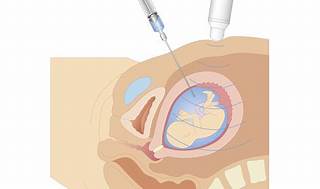A nurse is caring for a client who reports xerostomia following radiation therapy to the mandible.
Which of the following is an appropriate action by the nurse?
Suggest rinsing his mouth with an alcohol-based mouth wash.
Instruct the client on the use of esophageal speech.
Offer the client saltine crackers between meals.
Provide humidification of the room air.
The Correct Answer is D
Provide humidification of the room air. This is because humidification can help moisten the oral mucosa and reduce the discomfort of xerostomia. Xerostomia is a condition of dry mouth caused by reduced or absent saliva flow, which can occur after radiation therapy to the head and neck area.
Choice A is wrong because rinsing the mouth with an alcohol-based mouth wash can irritate the oral tissues and worsen xerostomia. Alcohol can also dehydrate the mouth and reduce saliva production.
Choice B is wrong because esophageal speech is a method of voice restoration after laryngectomy, not a treatment for xerostomia.
Esophageal speech involves swallowing air into the esophagus and releasing it to create sound.
It has nothing to do with saliva flow or dry mouth.
Choice C is wrong because saltine crackers are dry and hard to swallow without adequate saliva.
They can also scratch the oral mucosa and cause pain or bleeding. Offering the client saltine crackers between meals can aggravate xerostomia and increase the risk of choking.
Normal ranges for saliva flow vary depending on the method of measurement, but generally, a stimulated saliva flow rate of less than 0.7 mL/min or an unstimulated saliva flow rate of less than 0.1 mL/min is considered indicative of xerostomia.
Nursing Test Bank
Naxlex Comprehensive Predictor Exams
Related Questions
Correct Answer is C
Explanation

Explore
The correct answer is choice c. Contractions.
Choice A rationale:
Epigastric pain is not a common complication following an amniocentesis. It is more often associated with conditions like preeclampsia or gastrointestinal issues.
Choice B rationale:
Hypertension is not directly related to amniocentesis. It is more commonly associated with conditions like preeclampsia or chronic hypertension in pregnancy.
Choice C rationale:
Contractions are a significant complication to monitor for after an amniocentesis, especially at 33 weeks of gestation. The procedure can sometimes induce preterm labor.
Choice D rationale:
Vomiting is not a typical complication following an amniocentesis. It may occur due to other unrelated reasons but is not directly linked to the procedure.
Correct Answer is A
Explanation
The correct answer is choice A. “The more my baby is at the breast sucking, the more milk I will produce.” This statement indicates an understanding of the teaching because it reflects the principle of supply and demand in breastfeeding. The more the baby stimulates the breast, the more milk the mother will produce.
Choice B is wrong because manually expressing milk will not decrease the milk supply. In fact, it can help increase the milk supply by removing more milk from the breast and signaling the body to make more.
Choice C is wrong because the breast is not emptied after 5 to 10 minutes of feeding. The baby should be allowed to nurse until they are satisfied and show signs of fullness, such as releasing the nipple, falling asleep, or turning away from the breast. The average duration of a feeding session can vary from 10 to 45 minutes.
Choice D is wrong because the baby should not always start on the same breast when feeding. The mother should alternate which breast she offers first to ensure both breasts are stimulated and drained equally.
This can help prevent engorgement, mastitis, and low milk supply. A simple way to remember which breast to start with is to wear a bracelet or a clip on the bra strap on the side that needs to be offered next.
Whether you are a student looking to ace your exams or a practicing nurse seeking to enhance your expertise , our nursing education contents will empower you with the confidence and competence to make a difference in the lives of patients and become a respected leader in the healthcare field.
Visit Naxlex, invest in your future and unlock endless possibilities with our unparalleled nursing education contents today
Report Wrong Answer on the Current Question
Do you disagree with the answer? If yes, what is your expected answer? Explain.
Kindly be descriptive with the issue you are facing.
